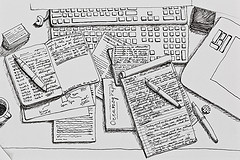Notetaking vs notemaking
By Mary Bigelow
Posted on 2014-08-06
 I really want to stop “giving” notes to students because it doesn’t seem like a good use of class time. They use tablets, so they can find facts easily, but I want students to actually manipulate the content and think about it. But I’m struggling a bit with letting go of the notes. Guidance or thoughts?
I really want to stop “giving” notes to students because it doesn’t seem like a good use of class time. They use tablets, so they can find facts easily, but I want students to actually manipulate the content and think about it. But I’m struggling a bit with letting go of the notes. Guidance or thoughts?
—Kelly, Raleigh, North Carolina
From my review of the notetaking literature (a focus of my dissertation), I found two schools of thought. One was note taking as a record of events. This would correspond to the minutes of a meeting or a transcript of a video. With this concept, teachers would give students a copy of important facts as a handout or file (or make the students copy them from the board or screen). Every student would have the same information in a standard style. [I’ve interviewed students who listed copying notes as their least favorite class activity.]
The other thought is notetaking as a form of information processing (notemaking might be a better term). As students read text, listen to a lecture, participate in a discussion, or watch a video, they connect what they’re seeing or hearing to what they already know, ask questions, reflect on their understanding, and summarize. This could be in a variety of formats depending on the information: Cornell notes, sketches, lists, annotating text, graphic organizers. Much of the literature on science notebooks reflects this concept of note taking.*
Do students know how to make their own notes? As veteran learners, we teachers often take things for granted, but if students are used to having notes given to them, they’ll need guidance. I observed a chemistry teacher who did this effectively. He projected the text on the board (the students had their own copies) as he read the text aloud. He paused and noted key words such as most important, three reasons for…, first. He underlined a few key phrases and annotated the margins with key terms or questions from the paragraph. After a page or two, he encouraged students to try this on their own as he circulated around the room and monitored their efforts. With a notemaking approach, teachers need to accept that students’ notes will not be uniform.
Regardless of the approach you use, the key is what students do with the notes. If they’re stored on a device or online, do they have access to them at home? Can they archive the notes for another year or class? Do students know how to use notes for review? Can they use them during other activities? Younger or less experienced students will need your guidance, modeling, scaffolding, and feedback to learn to use their notes.
Here are some additional suggestions from a recent e-mail list discussion**:
- Ellen: I have a 1:1 classroom, but I have not let go of the notes for seventh graders. I’m finding that they type them, but don’t use them. Also, there is a lot to be said for the thought process we use when we write a sentence. I see so many students that are looking at the keys worrying about spelling that the iPad is telling them is wrong. Then there are the growing children whose large fingers have difficulty with the touch screen typing. I feel the muscle memory and mental processing [of handwriting] is easier for them. Lastly, there are those that NEED the paper form to mark up and to limit screen distractions.
- Arvilla: Due to shortened class time I went from having students copy down my notes Cornell-style while I lectured and demonstrated to a fill-in-the-blank style where I merely whited out parts of my typed overhead. I found that test scores really dropped significantly when I did that. Scores went up when I then incorporated those fill-in-the-blanks with an interactive notebook which required them to find ways to express those notes. I feel they do need to develop some level of notetaking skill.
- Nancy: I gave up “notes” a few years back and now work with a journal system, based on Teaching Science With Interactive Notebooks by Kellie Marcarelli. Each unit centers on the connection page with the big question, and students go back and add to this as each lesson is done with more thoughts and questions. I like this better as the students are able to think and create their own ideas instead of just repeating what they were given.
- I would agree with Jane’s idea for action research: Try out a unit or portion of a unit with your usual use of notes and another with their own version. Then ask your students what works best for them. In addition to your conversations with them, look at the assessment outcomes.
Adding to the discussion of 1:1 classrooms is a recent article “The Pen Is Mightier Than the Keyboard: Advantages of Longhand Over Laptop Note Taking,” summarized here.
Since you have tablets, it might be interesting to compare traditional handwritten notes with notes taken via a stylus on the tablet. Please share your results!
* I’ve created a notebook resource collection in the NSTA Learning Center on the topic of notebooks and notes.
**There is also a related discussion in NSTA’s Community Forums.
Photo: https://flic.kr/p/bbqqTR
Disclaimer: The views expressed in this blog post are those of the author(s) and do not necessarily reflect the official position of the National Science Teaching Association (NSTA).


